Special edition of Key Small Business Statistics
PDF Version
The Canadian Provinces - September 2013
915 KB, 35 pages
Table of Contents
- Foreword
- Highlights
- How do we define and categorize businesses?
- Introduction
- Part A: Number of Business Establishments, Rural/Urban Distribution and Jobs in SMEs
- Part B: SME Owners' Reported Growth
- Part C: SMEs and Innovation
- Part D: SMEs in International Markets
- Part E: SME Applications for External Funding
- Part F: Demographic Profile of SME Owners
- Conclusion
Foreword
This special publication, The Canadian Provinces, completes the Key Small Business Statistics annual publication and provides readers with a picture of small and medium-sized enterprises (SMEs) in Canadian provinces with a focus on the diversity within the country's borders. This document is based on data taken from Statistics Canada's 2011 Survey on Financing and Growth of Small and Medium Enterprises,Footnote 1 Business Register, 2012Footnote 2 and Labour Force Survey, 2012.Footnote 3
Highlights
Number of SMEs per 1,000 working-age inhabitants
- Although more than half of the SMEs in Canada are concentrated in Ontario and Quebec, Alberta and Saskatchewan have the highest number of SMEs relative to the total working-age population (15 years old or older), i.e., 50.3 SMEs per 1,000 inhabitants in Alberta and 47.8 in Saskatchewan.
Jobs
- While 89.9 percent of jobs across the country are in SMEs, this proportion is highest in Prince Edward Island (94.3 percent) and Nova Scotia (94.1 percent).
Growth map
- Saskatchewan ranks first in terms of the proportion of high-growth SMEs (13.2 percent), followed by Alberta (9.3 percent) and British Columbia (9.2 percent).
Innovation
- Between 2009 and 2011, 37.8 percent of Canadian SMEs declared having conducted at least one innovation project in the previous three years. This proportion is highest in Ontario (44.2 percent) and Manitoba (40.9 percent).
Exporting
- Although the United States is a market for almost 90 percent of Canadian SME exporters, they export to all areas of the world. British Columbia has the greatest diversity of export markets outside the United States.
Applications for external funding
- In Quebec, 16 percent of the total value of approved funding came from public financial institutions and government programs, compared with less than 6 percent in all other regions of Canada.
Demographic profile of owners
- The highest proportion of SMEs partly owned by women occurs in the Prairies (53.7 percent) and the lowest in Quebec (37.8 percent).
- Saskatchewan (17.2 percent) has the highest proportion of SMEs led by young entrepreneurs (less than 40 years old).
- British Columbia (28.6 percent) has the highest proportion of SMEs with majority owners born outside of Canada.
- On average in Canadian provinces, more than half of the SMEs have a majority owner with a post-secondary diploma. This proportion is highest in Alberta (70.9 percent) and Ontario (70.8 percent).
How do we define and categorize businesses?
The term "business" refers to registered business establishments. To be included in our sample population, a business establishment must meet one of the following criteria: have at least one paid employee (with payroll deductions remitted to the Canada Revenue Agency (CRA)), have annual sales revenues of $30,000, or be incorporated and have filed a federal corporate income tax return at least once in the previous three years. As Industry Canada uses a definition based on the number of paid employees in this publication, our analysis excludes the self-employedFootnote 4 and "indeterminate"Footnote 5 businesses. Also excluded from the sample population are businesses in the following industrial sectors: public administration, including schools and hospitals; public utilities; and non-profit associations.Footnote 6
The size of a business establishment can be defined in many ways: annual sales or shipments, annual gross or net revenue, assets or number of employees. Among these measures, the approach using the number of employees to determine the size of businesses is widely used to categorize businesses. Data for this measure are often easiest to collect from surveyed businesses and help to facilitate cross-country comparisons. Accordingly, in this report, an SME is a business establishment with 1–499 paid employees, more specifically:
- A small business has 1 to 99 paid employees.Footnote 7
- A medium-sized business has 100 to 499 paid employees.
- A large business has 500 or more paid employees.
Introduction
Canada is characterized by great economic and political diversity. The natural resources located within provincial borders and the provinces' discretionary power over taxes and business assistance are just some of the things that make Canada's economic landscape so diverse. As shown in this report, the group of provinces that make up Canada is a heterogeneous rather than homogeneous set of parts. The data presented and explained, accordingly, focus on the particular characteristics of each province. Given the statistics available, this report does not include data on the territories, only the ten Canadian provinces.
The report is divided into six parts. Part A presents data on the number of SMEs, their rural/urban distribution and private-sector jobs in SMEs. Part B presents data on SME growth. Part C presents data on innovation. Part D deals with SME strategies with respect to international markets. Part E presents data on business start-up and external funding for SMEs. Finally, Part F establishes the demographic profile of SME majority owners and chief executive officers.
Part A: Number of Business Establishments, Rural/Urban Distribution and Jobs in SMEs
Number of business establishments
In 2012, the number of small businesses (fewer than 100 employees) in the Canadian provinces totalled 1.08 million business establishments, while the number of medium-sized businesses (between 100 and 499 employees) totalled 18,112 business establishments (Table 1). As there were 1,565 large companies in the provinces, for a total of about 1.10 million businesses with employees, SMEs represented close to 99.9 percent of all business establishments with employees (98.2 percent for small businesses and 1.6 percent for medium-sized businesses). This distribution is similar in all of Canada's provinces.
| Province | Business establishments with employees | Small businesses (1–99 employees) | Medium-sized businesses (100–499 employees) | Large businesses (500+ employees) | Percentage of small and medium-sized enterprises |
|---|---|---|---|---|---|
| Source: Statistics Canada, Business Register, December 2012. | |||||
| All provinces | 1,104,213 | 1,084,536 | 18,112 | 1,565 | 99.9 |
| Newfoundland and Labrador | 17,335 | 17,090 | 233 | 12 | 99.9 |
| Prince Edward Island | 5,615 | 5,547 | 64 | 4 | 99.9 |
| Nova Scotia | 29,686 | 29,179 | 468 | 39 | 99.9 |
| New Brunswick | 24,992 | 24,582 | 386 | 24 | 99.9 |
| Quebec | 236,688 | 232,531 | 3,830 | 327 | 99.9 |
| Ontario | 389,116 | 381,001 | 7,437 | 678 | 99.8 |
| Manitoba | 35,980 | 35,298 | 622 | 60 | 99.8 |
| Saskatchewan | 38,749 | 38,264 | 457 | 28 | 99.9 |
| Alberta | 154,495 | 151,866 | 2,397 | 232 | 99.9 |
| British Columbia | 171,557 | 169,178 | 2,218 | 161 | 99.9 |
Figure 1 shows the number of SMEs relative to the total working-age population (15 years old or older) in the provinces. Using this ratio, on average, there are around 39 SMEs per 1,000 inhabitants. Alberta (50.3), Saskatchewan (47.8) and Prince Edward Island (46.6) have the highest number of SMEs relative to the total working-age population, while the two most populous provinces, i.e., Ontario (35.2) and Quebec (35.7), have the lowest number.
Figure 1: Number of SMEs per 1,000 working-age inhabitants
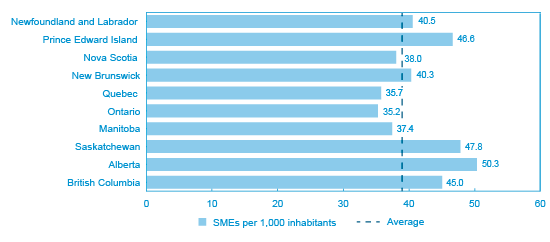
Sources: Statistics Canada, Business Register, December 2012; Statistics Canada, Labour Force Survey, 2012; and calculations by Industry Canada.
Rural/urban distribution of SMEs
According to Statistics Canada, an urban area is an area with a population of at least 1,000 inhabitants and a population density of at least 400 inhabitants per square kilometre. Rural areas are all areas that do not meet these criteria. Figure 2, which provides the distribution of Canadian SMEs according to type of area (rural or urban) where the business is physically located, shows that the vast majority of SMEs are located in urban areas (82 percent). This is particularly the case in New Brunswick (98.7 percent) and British Columbia (88.2 percent). In other provinces, however, a significant proportion of SMEs is located in rural areas. This is particularly true in Prince Edward Island (50.5 percent), Saskatchewan (45.1 percent) and Newfoundland and Labrador (42.4 percent).
Figure 2: Breakdown of SMEs by type of area where the business establishment is physically located
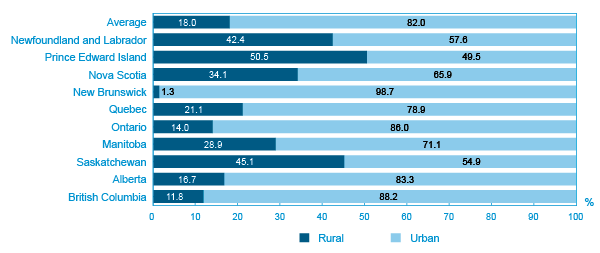
Source: Statistics Canada, Business Register, December 2012.
Jobs in SMEs
SMEs in the provinces employ around 10 million private-sector workers, i.e., 89.9 percent of all private-sector jobs (Table 2). Small businesses account for 69.7 percent of these jobs. Prince Edward Island (94.3 percent) and Nova Scotia (94.1 percent) have the highest proportions of jobs in SMEs, while Quebec (87.5 percent) and Ontario (88.5 percent) have the lowest proportions.
| Province | Small businesses (1–99 employees) | Medium-sized businesses (100–499 employees) | Large businesses (500+ employees) | Total jobs in SMEs | Total jobs, all business sizes | Percentage of private-sector jobs in SMEs |
|---|---|---|---|---|---|---|
| Source: Statistics Canada, Labour Force Survey, 2012. | ||||||
| All provinces | 7,745,704 | 2,247,780 | 1,121,025 | 9,993,484 | 11,114,508 | 89.9 |
| Newfoundland and Labrador | 102,982 | 24,535 | 9,921 | 127,518 | 137,439 | 92.8 |
| Prince Edward Island | 33,079 | 5,534 | 2,353 | 38,613 | 40,966 | 94.3 |
| Nova Scotia | 213,442 | 53,539 | 16,606 | 266,981 | 283,587 | 94.1 |
| New Brunswick | 159,525 | 44,902 | 16,653 | 204,427 | 221,080 | 92.5 |
| Quebec | 1,684,396 | 521,702 | 315,724 | 2,206,098 | 2,521,822 | 87.5 |
| Ontario | 2,887,141 | 949,869 | 497,440 | 3,837,010 | 4,334,450 | 88.5 |
| Manitoba | 275,847 | 73,749 | 31,316 | 349,596 | 380,913 | 91.8 |
| Saskatchewan | 231,064 | 50,544 | 20,123 | 281,608 | 301,731 | 93.3 |
| Alberta | 1,053,224 | 262,003 | 118,553 | 1,315,227 | 1,433,780 | 91.7 |
| British Columbia | 1,105,002 | 261,403 | 92,334 | 1,366,406 | 1,458,740 | 93.7 |
Part B: SME Owners' Reported Growth
Growth rate is a key indicator of a business' state of health. Administrative data from Statistics Canada and the Organisation for Economic Cooperation and Development indicates that the percentage of firms that have grown 20 percent between 2006 and 2009 is relatively small.Footnote 8. Indeed, during this period, 4.6 percent of firms of all sizes met this definition in terms of revenue, and 3.1 percent if we accounted for employment.
While the measure above generally applies to all firms as a group, there have been efforts to focus specifically on small and medium firms through statistical surveys covering the 2009–2011 period.Footnote 9 Even though the answers rely on the perceptions of the owners about the state of growth of their business, the results nevertheless provide new information on growing firms and give a sense of the ranking among provinces.
Figure 3 shows the proportions of SMEs that achieved an annual growth of 20 percent or more in terms of revenue or sales between 2009 and 2011, and the proportions of SMEs anticipating the same growth over the 2012–2014 period. On average, 7.7 percent of SMEs were reported to have achieved that growth between 2009 and 2011. Almost the same proportion of SMEs (7.5 percent) anticipates 20 percent or more annual growth in terms of revenue or sales between 2012 and 2014.
Figure 3: Percentage of growth SMEs, in terms of revenue or sales (20 percent and higher), for 2009–2011 and percentage of SMEs anticipating growth for 2012–2014, by province or region
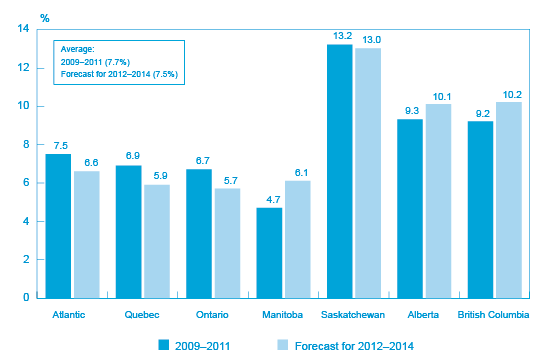
Source: Statistics Canada, Survey on Financing and Growth of Small and Medium Enterprises, 2011.
Saskatchewan ranks first, in terms of both the proportion of growth SMEs (13.2 percent) and the proportion of SMEs anticipating high growth (13 percent), followed by Alberta (9.3 percent and 10.1 percent respectively) and British Columbia (9.2 percent and 10.2 percent respectively). The other regions show lower proportions of growth SMEs. Forecasts for high growth between 2012 and 2014 are lower still, except for Manitoba at 6.1 percent.
On the other hand, the number of SMEs that saw a drop in revenue or sales between 2009 and 2011 remains significant (16.1 percent), particularly in the wholesale (20.6 percent) and retail (22.7 percent) sectors.
Of the provinces, British Columbia (19 percent) has the highest proportion of SMEs that saw a decline in revenue or sales, followed by Ontario (17.6 percent) and Quebec (16.3 percent) (Figure 4). As with growth, SMEs in Saskatchewan performed best, with only 7 percent recording a drop in revenue or sales between 2009 and 2011.
Figure 4: Percentage of SMEs that recorded a decline in revenue or sales over the 2009–2011 period and percentage of SMEs that foresee a decline over the 2012–2014 period, by province or region
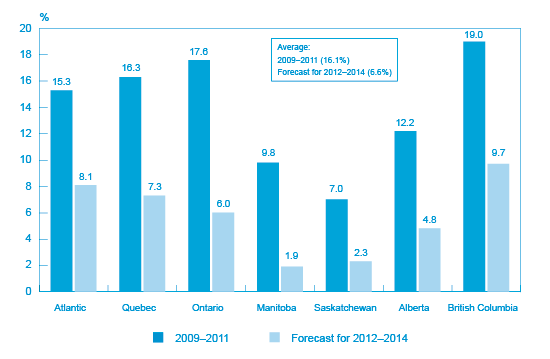
Source: Statistics Canada, Survey on Financing and Growth of Small and Medium Enterprises, 2011.
With regard to SME growth forecasts, only 6.6 percent foresee a decline in revenue or sales between 2012 and 2014, i.e., a drop of around 59 percent compared with the proportion of SMEs that foresaw the same situation between 2009 and 2011. In Ontario and Manitoba, about three and five times fewer SMEs, respectively, foresee a drop in revenue or sales between 2012 and 2014 compared with the number of SMEs that recorded a drop in revenue or sales between 2009 and 2011.
The optimism of SME owners regarding future growth is highlighted in Table 3, which shows the business growth intervals as well as growth forecasts. The proportion of SME owners across the regions anticipating zero growth in revenue or sales between 2012 and 2014 is considerably lower than the proportion of SMEs that saw such stagnation between 2009 and 2011. In Saskatchewan, approximately half the number of SMEs foresee zero growth between 2012 and 2014 compared with the previous period.
| Province or region | Zero growth | Between 1 percent and 10 percent | Between 11 percent and 20 percent | |||
|---|---|---|---|---|---|---|
| 2009–2011 | 2012–2014 forecast | 2009–2011 | 2012–2014 forecast | 2009–2011 | 2012–2014 forecast | |
| Source: Statistics Canada, Survey on Financing and Growth of Small and Medium Enterprises, 2011 | ||||||
| All provinces | 22.1 | downward 17.7 | 43.6 | upward 56.2 | 10.5 | upward 12.1 |
| Atlantic | 16.4 | downward 14.7 | 50.0 | upward 60.2 | 10.8 | downward 10.5 |
| Quebec | 23.3 | downward 20.9 | 42.3 | upward 54.7 | 11.1 | upward 11.2 |
| Ontario | 21.3 | downward 17.6 | 44.0 | upward 58.8 | 10.4 | upward 11.9 |
| Manitoba | 25.2 | downward 15.7 | 51.8 | upward 66.0 | 8.5 | upward 10.3 |
| Saskatchewan | 25.5 | downward 12.8 | 44.9 | upward 54.5 | 9.4 | upward 17.5 |
| Alberta | 20.8 | downward 17.0 | 47.2 | upward 55.0 | 10.5 | upward 13.1 |
| British Columbia | 23.9 | downward 17.3 | 37.4 | upward 50.5 | 10.5 | upward 12.4 |
For the two higher growth intervals identified in Table 3, i.e., between 1 percent and 10 percent and between 11 percent and 20 percent, the proportion of SME owners anticipating growth of this magnitude between 2012 and 2014 is higher than the proportion that anticipated such growth over the previous period (except for the Atlantic region, where SME owners anticipate 10.5 percent growth between 2012 and 2014 compared with 10.8 percent growth over the 2009—2011 period).
Several factors can explain sluggish or stagnant growth within a business. As shown in Tables 4.1 and 4.2, obstacles to growth can be internal or external to the company. The two main external obstacles to growth cited by Canadian SMEs are the rise in input prices (63.2 percent of SMEs) and unstable demand (52.2 percent), while the main internal obstacles to growth are employee recruitment and retention (39 percent), the amount of time devoted to current operations (38.4 percent) and maintaining sufficient cash flow (37.2 percent).
| Province or region | Worker shortage | Unstable demand for products or services | Acquiring funding | Government regulations | Rise in input prices | Increased competition | Other |
|---|---|---|---|---|---|---|---|
| Source: Statistics Canada, Survey on Financing and Growth of Small and Medium Enterprises, 2011 | |||||||
| All provinces | 33.1 | 52.2 | 16.8 | 33.5 | 63.2 | 47.9 | 22.2 |
| Atlantic | 27.6 | 54.8 | 18.2 | 40.2 | 82.0 | 37.5 | 24.5 |
| Quebec | 35.0 | 35.9 | 17.6 | 33.1 | 48.3 | 45.4 | 21.1 |
| Ontario | 27.9 | 57.5 | 17.7 | 33.9 | 67.6 | 52.8 | 24.4 |
| Manitoba | 37.9 | 47.6 | 7.4 | 31.8 | 65.2 | 49.0 | 17.3 |
| Saskatchewan | 50.0 | 44.3 | 10.3 | 23.9 | 59.5 | 39.4 | 19.4 |
| Alberta | 43.8 | 52.0 | 15.7 | 26.3 | 62.9 | 47.6 | 16.4 |
| British Columbia | 31.0 | 63.1 | 17.4 | 37.9 | 65.9 | 46.9 | 23.9 |
| Province or region | Debt-level management | Maintaining sufficient cash flow | Insufficient monitoring of business operations to make changes | Insufficient knowledge of competitors or market trends | Too much time spent on current operations | Employee recruitment and retention | Other |
|---|---|---|---|---|---|---|---|
| Source: Statistics Canada, Survey on Financing and Growth of Small and Medium Enterprises, 2011 | |||||||
| All provinces | 18.3 | 37.2 | 16.3 | 13.3 | 38.4 | 39.0 | 9.4 |
| Atlantic | 20.2 | 41.8 | 14.0 | 11.2 | 35.3 | 33.3 | 7.6 |
| Quebec | 10.4 | 31.8 | 13.6 | 15.9 | 30.3 | 35.8 | 9.3 |
| Ontario | 23.9 | 41.7 | 16.1 | 12.4 | 40.2 | 37.1 | 9.3 |
| Manitoba | 19.0 | 29.6 | 16.9 | 13.2 | 37.8 | 51.1 | 8.9 |
| Saskatchewan | 12.9 | 29.3 | 18.5 | 11.7 | 37.7 | 53.6 | 9.1 |
| Alberta | 17.7 | 34.0 | 18.2 | 12.2 | 42.7 | 42.9 | 9.7 |
| British Columbia | 17.0 | 38.7 | 19.0 | 13.7 | 43.2 | 40.6 | 10.4 |
However, the two tables underscore significant variations in both internal and external obstacles to SME growth among the regions. The fact that some obstacles are predominant in specific regions speaks to the heterogeneity of economic realities within the country.
In terms of external factors, the rise in input prices is considered a significant obstacle to the growth of SMEs in most provinces (varying from 59.5 percent to 82 percent), but less so for Quebec SMEs (48.3 percent). In addition, 50 percent of SMEs in Saskatchewan and 43.8 percent of SMEs in Alberta estimate that they are dealing with a shortage of workers, while only 27.6 percent of SMEs in the Atlantic region cite the same obstacle. Unstable demand for products and services is another important obstacle cited, particularly in Ontario (57.5 percent) and British Columbia (63.1 percent).
Employee recruitment and retention is considered an important internal obstacle to SME growth, especially for SMEs in Saskatchewan (53.6 percent) and Manitoba (51.1 percent), but less so for SMEs in the Atlantic region (33.3 percent). Furthermore, the time spent on current operations is deemed to be a serious obstacle in British Columbia (43.2 percent) and Alberta (42.7 percent), but less so in Quebec (30.3 percent). Finally, maintaining sufficient cash flow is a major internal obstacle in the Atlantic region (41.8 percent) and Ontario (41.7 percent), but less so in Saskatchewan (29.3 percent) and Manitoba (29.6 percent).
Part C: SMEs and Innovation
Businesses innovate for a number of reasons, including to distinguish themselves in the markets, foster growth and, ultimately, ensure the company's survival. Canadian SMEs are no exception. Although innovation is often associated with the development and marketing of revolutionary products, it is, in fact, a continuous process aiming to improve numerous aspects of the business (see box).
Box
The Organisation for Economic Co-operation and Development (OECD) defines four main types of innovation:Footnote 10
- Product innovation is the introduction of a good or service that is new or significantly improved with respect to its characteristics or intended uses.
- Process innovation is the implementation of a new or significantly improved production or delivery method.
- Organizational innovation is the implementation of a new organizational method in the firm's business practices, workplace organization or external relations.
- Marketing innovation is the implementation of a new marketing method involving significant changes in product design or packaging, product placement, product promotion or pricing.
Between 2009 and 2011, 37.8 percent of Canadian SMEs declared having conducted at least one innovation project in the previous three years (Figure 5). Ontario (44.2 percent) and Manitoba (40.9 percent) recorded the highest proportions of SMEs to conduct at least one innovation project over this period, while Quebec ranked last (29.4 percent).
Figure 5: Percentage of SMEs that conducted at least one innovation project between 2009 and 2011 by region or province
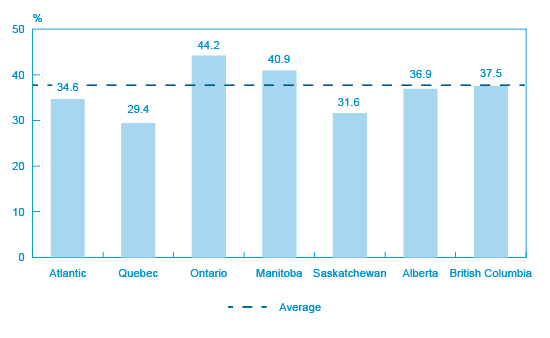
Source: Statistics Canada, Survey on Financing and Growth of Small and Medium Enterprises, 2011.
As shown in Table 5, the types of innovation projects undertaken by SMEs varied quite a bit depending upon the region and type of innovation. Approximately one in four SMEs across the country (23.7 percent) conducted a product innovation project over the 2009–2011 period. As for the three other main types of innovation, 14.5 percent of SMEs conducted a process innovation project, 14.9 percent conducted an organizational innovation project and 16.6 percent conducted a marketing innovation project.
| Province or region | New or significantly improved good or service (product innovation) | New or significantly improved production or delivery method (process innovation) | New organizational method in business practices, workplace organization or external relations (organizational innovation) | New way of selling products or services (marketing innovation) |
|---|---|---|---|---|
| Source: Statistics Canada, Survey on Financing and Growth of Small and Medium Enterprises, 2011 | ||||
| All provinces | 23.7 | 14.5 | 14.9 | 16.6 |
| Atlantic | 18.6 | 14.9 | 15.8 | 15.8 |
| Quebec | 17.7 | 10.6 | 10.0 | 11.8 |
| Ontario | 30.2 | 17.4 | 17.6 | 20.4 |
| Manitoba | 23.2 | 18.1 | 21.6 | 17.8 |
| Saskatchewan | 22.2 | 17.0 | 10.7 | 13.9 |
| Alberta | 21.4 | 12.8 | 14.6 | 12.9 |
| British Columbia | 22.3 | 13.3 | 15.1 | 18.5 |
It was possible to distinguish certain trends among the provinces. While SMEs in Ontario and Manitoba are ahead in two categories, Quebec ranks last for all four categories of innovation.
Businesses invest significant financial resources in innovation projects for a number of strategic reasons, particularly to increase sales, drive down production costs and increase market share. Across the country, 69.9 percent of the SMEs that innovated between 2009 and 2011 saw an increase in sales after implementing their innovation projects (Table 6). In Saskatchewan, three out of four innovating SMEs saw a rise in sales after implementing their innovation projects.
| Province or region | Increase in sales | Reduction of costs | Increase in business' existing market share | No result |
|---|---|---|---|---|
| Source: Statistics Canada, Survey on Financing and Growth of Small and Medium Enterprises, 2011 Note: Some data were omitted from the analysis to meet confidentiality requirements of the Statistics Act or due to poor quality. In such cases, a dash was used instead. | ||||
| All provinces | 69.9 | 35.4 | 60.5 | 8.7 |
| Atlantic | 69.5 | 37.4 | 61.7 | 7.0 |
| Quebec | 69.1 | 28.9 | 67.4 | 8.2 |
| Ontario | 71.0 | 37.0 | 59.8 | 9.4 |
| Manitoba | 73.1 | 40.1 | 64.4 | - |
| Saskatchewan | 75.0 | 43.7 | 60.8 | - |
| Alberta | 67.9 | 31.5 | 64.2 | 11.3 |
| British Columbia | 68.0 | 37.3 | 51.4 | 7.9 |
Across the country, only 8.7 percent of innovating SMEs saw no results after implementing their innovation projects. This proportion varies from 7.0 percent of innovating SMEs in the Atlantic region to 11.3 percent in Alberta. For 35.4 percent of the SMEs that innovated between 2009 and 2011, the innovation projects led to a drop in production costs. This proportion is highest in Saskatchewan (43.7 percent) and lowest in Quebec (28.9 percent). Furthermore, 60.5 percent of innovating SMEs across the country saw their market shares increase after implementing their innovation projects. In Quebec, this proportion rose to 67.4 percent. Tables 5 and 6 suggest that, although a fairly low proportion of businesses in Saskatchewan conducted innovation projects, implementation of these projects is yielding very good results.
Table 7 presents the main reasons why some SMEs chose not to undertake an innovation project between 2009 and 2011. Across the country, 74.7 percent of SMEs that declared not innovating over this period estimated that the market did not need new products or processes; 4.1 percent cited a lack of financial resources and 1.7 percent cited a lack of trained personnel. However, a high number of SMEs cited other reasons (19.5 percent). Although the Survey on Financing and Growth of Small and Medium Enterprises does not specify these reasons, other statistical surveys and research in the field mention uncertainty, feasibility risks, bureaucracy and ignorance of grant programs as obstacles to innovation.Footnote 11
| Province or region | Market does not need new products or processes / business does not need to innovate / innovation is not part of company's business plan | Lack of financial resources to conduct innovation projects | Lack of personnel trained to conduct innovation projects | Other reasons |
|---|---|---|---|---|
| Source: Statistics Canada, Survey on Financing and Growth of Small and Medium Enterprises, 2011 Note: Some data were omitted from the analysis to meet confidentiality requirements of the Statistics Act or due to poor quality. In such cases, a dash was used instead. | ||||
| All provinces | 74.7 | 4.1 | 1.7 | 19.5 |
| Atlantic | 82.7 | 4.4 | 1.4 | 11.5 |
| Quebec | 78.3 | 3.0 | 2.6 | 16.1 |
| Ontario | 74.3 | 4.4 | 0.5 | 21.0 |
| Manitoba | 66.1 | - | - | 28.3 |
| Saskatchewan | 73.5 | - | - | 18.3 |
| Alberta | 76.6 | 3.3 | 0.2 | 19.8 |
| British Columbia | 75.9 | 5.0 | 1.9 | 17.2 |
At the provincial level, the Atlantic region had the highest number of SMEs (82.7 percent) declaring that the market did not need new products or processes, while the lowest proportion was in Manitoba (66.1 percent). A lack of financial resources was cited in a proportion varying from 3 percent for Quebec to 5 percent for British Columbia. With regard to a lack of personnel trained to undertake such projects, the proportion was highest in Quebec (2.6 percent) and lowest in Alberta (0.2 percent). Several other reasons specific to particular businesses also explain the absence of innovation (Table 7). This is especially evident in Manitoba, where 28.3 percent of SMEs that conducted no innovation projects between 2009 and 2011 cited reasons other than those mentioned in the survey.
In Canada, the Intellectual Property Office is responsible for regulating the assignment of intellectual property rights protecting innovations. Intellectual property rights ensure exclusive use of innovations and are intangible assets that can be traded on the market.Footnote 12 Traditionally, the bigger the company, the more it will be inclined to hold intellectual property rights. Furthermore, intellectual property rights are particularly important for businesses that offer high value-added products. Across provinces, 15.8 percent of SMEs have at least one type of intellectual property. At the provincial level, this proportion is highest in Ontario at 20 percent of the province's SMEs, followed by British Columbia at 15.9 percent (Figure 6). However, the other provinces or regions are below the Canadian average. Alberta (14.6 percent) falls just below the national average, and the provinces with the lowest proportions are Saskatchewan (11.3 percent), Quebec (11.8 percent) and the Atlantic region (12.4 percent).
Figure 6: Percentage of SMEs holding a type of intellectual property by region or province
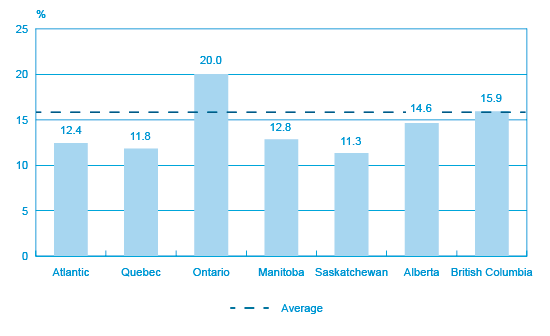
Source: Statistics Canada, Survey on Financing and Growth of Small and Medium Enterprises, 2011
Part D: SMEs in International Markets
SME exporting
In 2011, 10.2 percent of small businesses and 34.4 percent of medium-sized businesses exported goods or services. While Canadian enterprises of all sizes exported goods with a total value of approximately $374 billion in 2011,Footnote 13 the shares by firm size were 23.9 percent for small businesses, 16.2 percent for medium-sized businesses and 59.9 percent for large businesses respectively.
The proportion of exporting SMEs varies widely from region to region. In 2011, 12.8 percent of SMEs in Ontario and 11.9 percent of SMEs in Manitoba exported, compared with 3.9 percent of SMEs in Saskatchewan and 6 percent of SMEs in Alberta (Figure 7).
Figure 7: Percentage of SMEs that exported goods or services in 2011 by region or province
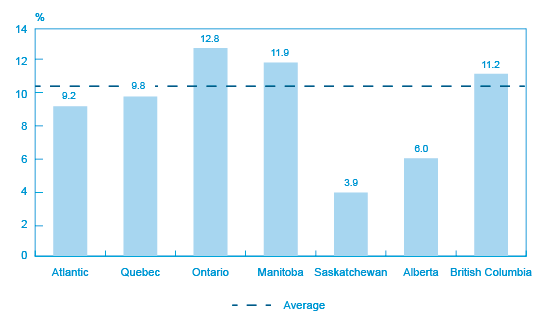
Source: Statistics Canada, Survey on Financing and Growth of Small and Medium Enterprises, 2011.
SME export markets
SMEs that export goods or services do so to many areas around the world. The main export markets in 2011 were the United States (89.3 percent of exporting SMEs) and Europe (32.1 percent).Footnote 14 Although these two markets were important for all of the provinces, this trend was stronger for some. For example, almost all exporting SMEs in Saskatchewan (99.1 percent) exported to the United States and more than half of the SMEs in the Atlantic region (54.8 percent) exported to Europe (Figure 8).
Figure 8: Markets for exporting SMEs in 2011
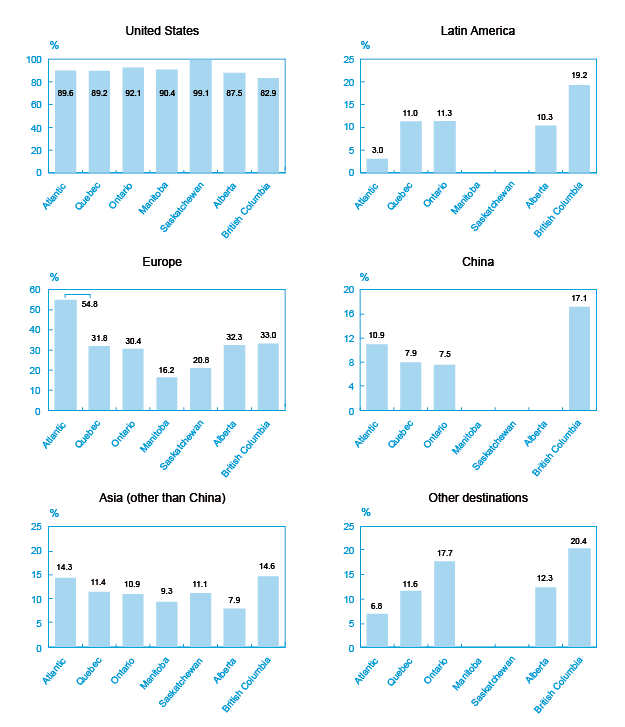
Source: Statistics Canada, Survey on Financing and Growth of Small and Medium Enterprises, 2011.
Note: For reasons of confidentiality, exports to Latin America and other destinations are not available for Manitoba and Saskatchewan, and exports to China are not available for Manitoba, Saskatchewan and Alberta.
However, British Columbia stands out from the other provinces in this regard. Although the United States is still an important destination for exports from British Columbia's SMEs (82.9 percent), companies in British Columbia export to a wide variety of markets outside the United States: Europe (33 percent), Latin America (19.2 percent), China (17.1 percent), Asia (other than China) (14.6 percent) and other destinations (20.4 percent).
SME expansion projects into international markets
Managers adjust their business' export strategy based on their experience, the economic context and the financial health of their business. Some businesses export as soon as they open their doors, while others choose to export to international markets only when the business reaches a certain level of maturity. In 2011, 11.9 percent of SMEs planned to expand into international markets over the next three years (Figure 9). These SMEs include those that already export and those that do not but want to break into international markets. British Columbia ranks first with 15.9 percent of the province's SMEs planning to expand into international markets between 2012 and 2014. The Atlantic region has the lowest proportion, with only 7.9 percent of SMEs planning to expand into international markets.
Figure 9: Percentage of SMEs planning to expand into international markets between 2012 and 2014 by region or province

Source: Statistics Canada, Survey on Financing and Growth of Small and Medium Enterprises, 2011.
SME importing
The proportion of SMEs that import goods and services from abroad is considerably higher than the proportion of SMEs that export (Figure 10). Across the country, 25.8 percent of SMEs declared having imported goods or services in 2011. These proportions are highest in British Columbia, Alberta and Ontario, with 32.1 percent, 28.5 percent and 28 percent of SMEs importing respectively. The Atlantic region is where the proportion of SMEs that imported in 2011 is lowest (14.7 percent). Across the regions, the proportion of SMEs that imported goods or services in 2011 exceeds the proportion of SMEs that exported goods or services in the same year.
Figure 10: Percentage of SMEs that imported goods or services in 2011 by region or province

Source: Statistics Canada, Survey on Financing and Growth of Small and Medium Enterprises, 2011.
Part E: SME Applications for External Funding
When a business does not have access to enough funds internally, it has to look to external, sources of funding to meet various financial needs. These needs include acquisition of buildings, material and equipment; research and development; business start-up or acquisition of existing businesses; expansion of operations into international markets; and day-to-day funding of operations.
In 2011, 36 percent of SMEs in all of the provinces applied for external funding (Figure 11). In Manitoba and Saskatchewan, a little over four out of ten SMEs applied for external funding compared with only one in three SMEs in Ontario.
Figure 11: Percentage of SMEs that applied for external funding in 2011 by region or province
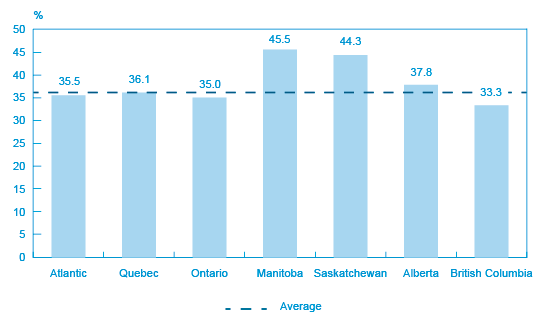
Source: Statistics Canada, Survey on Financing and Growth of Small and Medium Enterprises, 2011.
The same year, 65.9 percent of the total value of approved funding from various types of lenders came from debt financing (Figure 12). This source of funding includes short-term and mortgage loans, lines of credit and credit cards. The second biggest source of funding was trade credit granted by suppliers of goods and services to SMEs (11.4 percent). Equity financing, in the form of venture capital or loans from employees, friends and family of SME owners, represented 9.3 percent of the total value of authorized funding. The value of lease financing authorized to lease equipment and buildings represented 6.9 percent of the total, while the value of funding granted through public financial institutions and government programs represented 6.5 percent of the total amount of funding authorized for SMEs in 2011.
Figure 12: Breakdown of the total value of approved funding by type of funding requested and by region or province, 2011
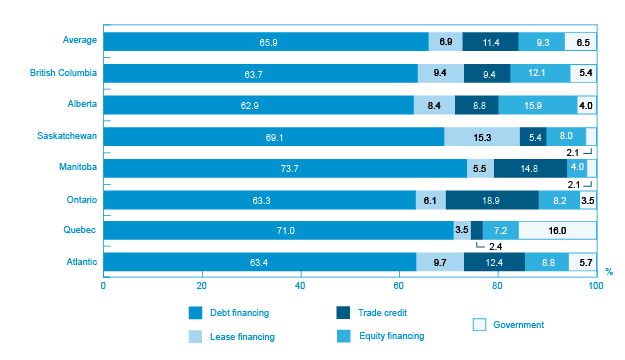
Source: Statistics Canada, Survey on Financing and Growth of Small and Medium Enterprises, 2011.
In Manitoba, 73.7 percent of the total value of approved funding came from debt financing compared with a little over 63 percent in the Atlantic region, Ontario and British Columbia. Authorized lease financing represented 15.3 percent of the total value of authorized funding in Saskatchewan compared with 3.5 percent in Quebec. Trade credit is used much more as a source of funding in Ontario (18.9 percent) and Manitoba (14.8 percent) than in Saskatchewan (5.4 percent). Equity financing is used more in Alberta (15.9 percent) and British Columbia (12.1 percent) than in other provinces (between 7 percent and 9 percent), particularly Manitoba (4 percent). It is also important to note that in Quebec, 16 percent of the total value of approved funding came from public financial institutions and government programs, compared with less than 6 percent in all other regions.
In 2011, a little over one out of four SME across the regions applied for debt financing (Figure 13) and close to 90 percent of these applications were approved in whole or in part (Figure 14). In Manitoba and Saskatchewan, approximately 33 percent of SME applied for debt financing and about 95 percent of the applications were approved in whole or in part. In British Columbia and Ontario, approximately 23 percent of SME applied for debt financing, with 93.6 percent of applications from SME in British Columbia being approved in whole or in part compared with 85.9 percent of applications from SME in Ontario being approved.
Figure 13: Percentage of SME that applied for debt financing in 2011 by region or province

Source: Statistics Canada, Survey on Financing and Growth of Small and Medium Enterprises, 2011.
Figure 14: Approval rateNote * referrer of Figure 14 of debt financing applications in 2011 by region or province
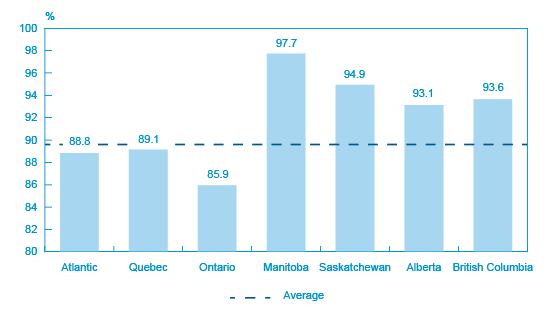
Source: Statistics Canada, Survey on Financing and Growth of Small and Medium Enterprises, 2011.
Note * of Figure 14 Approval in whole or in part of amount requested.
Part F: Demographic Profile of SME Owners
Like the demographics of Canadian society, the demographic profile of SME majority owners and chief executive officers in the provinces is characterized by diversity and change. A large number of SMEs are currently owned by women, young entrepreneurs or immigrants. However, the data in this report show that the demographic profile of SME owners does not always reflect that of Canadian society.
Female entrepreneursFootnote 15
The proportion of SMEs in which women hold between 1 percent and 100 percent of company shares varies between 53.7 percent in the Prairies and 37.8 percent in Quebec (Table 8). In the category where women hold 50 percent of company shares, the highest proportions are in the Prairies (23.4 percent) and British Columbia (21.9 percent), and the lowest proportion is in Quebec (9.7 percent). In the category where women hold 100 percent of company shares, the highest proportions are in the Atlantic region (16.9 percent) and Quebec (15 percent), and the lowest proportion is in the Prairies (11.1 percent).
| Province or region | 0 percent | 1 percent to 49 percent | 50 percent | 51 percent to 99 percent | 100 percent | 1 percent to 100 percent |
|---|---|---|---|---|---|---|
| Source: Statistics Canada, Survey on Financing and Growth of Small and Medium Enterprises, 2011 | ||||||
| All provinces | 53.9 | 12.5 | 18.1 | 2.1 | 13.4 | 46.1 |
| Atlantic | 52.4 | 12.5 | 15.1 | 3.0 | 16.9 | 47.5 |
| Quebec | 62.3 | 10.6 | 9.7 | 2.5 | 15.0 | 37.8 |
| Ontario | 54.3 | 11.8 | 19.0 | 1.8 | 13.2 | 45.8 |
| Prairies | 46.3 | 16.6 | 23.4 | 2.6 | 11.1 | 53.7 |
| British Columbia | 52.1 | 11.2 | 21.9 | 1.5 | 13.3 | 47.9 |
Age of entrepreneurs
Figure 15 shows the breakdown of SMEs by age of majority owner or chief executive officer. In every region or province of Canada, SMEs with a majority owner or chief executive officer aged 50 years or older account for more than half of all SMEs. The highest proportions of SMEs with a majority owner or chief executive officer aged 50 years or older are in the Atlantic region (64.1 percent), Ontario (62.3 percent) and Manitoba (60.1 percent), while Saskatchewan (51.9 percent) and Alberta (55.8 percent) have the lowest proportions.
Figure 15: Breakdown of SMEs by age of majority owner or chief executive officer (percentage of SMEs) by region or province

Source: Statistics Canada, Survey on Financing and Growth of Small and Medium Enterprises, 2011.
Note: Numbers may not add up to 100 percent due to rounding.
Comparing the proportions of SMEs headed by a young entrepreneurFootnote 16 (less than 40 years old) and those headed by someone older than 65 years provides a portrait that varies considerably from region to region (Figure 16). Two regions, i.e., the Atlantic region and Ontario, have more SMEs headed by someone older than 65 years than SMEs headed by someone less than 40 years old. These two regions also have the highest proportions of SMEs headed by someone older than 65 years (13.4 percent for Ontario and 12.8 percent for the Atlantic region). All other regions have more SMEs headed by someone less than 40 years old than SMEs headed by someone older than 65 years. Saskatchewan (17.2 percent) and Alberta (15.1 percent) have the highest proportions of SMEs headed by young entrepreneurs, and the Atlantic region (6.9 percent) and Ontario (9.4 percent) have the lowest proportions.
Figure 16: Percentage of SMEs owned or operated by a chief executive officer under 40 years of age and over 65 years of age by region or province

Source: Statistics Canada, Survey on Financing and Growth of Small and Medium Enterprises, 2011.
Immigrant entrepreneurs
In 2011, 21.7 percent of SMEs had a majority owner or chief executive officer born outside of Canada (Figure 17). The proportion of SMEs with a majority owner or chief executive officer born outside of Canada is highest in British Columbia (28.6 percent), Ontario (27.5 percent) and Alberta (24.5 percent) and lowest in the Atlantic region (11.3 percent), Quebec (11.2 percent) and Manitoba (11.3 percent).
Figure 17: Place of birth of company's majority owner or chief executive officer (percentage of SMEs) by region or province

Source: Statistics Canada, Survey on Financing and Growth of Small and Medium Enterprises, 2011.
Figure 18 compares the proportion of SMEs with a majority owner or chief executive officer born outside of Canada against the proportion of immigrants relative to the total population in the region.Footnote 17 This comparison highlights the representation of immigrants in executive positions in SMEs. On average for all of the provinces, the proportion of SMEs with a majority owner or chief executive officer born outside of Canada (21.7 percent) is higher than the proportion of people born abroad in the provinces (20.7 percent). It is interesting to note that in Saskatchewan and the Atlantic region, this proportion is about three times greater than the proportion of people born abroad in those areas. Although the two proportions are relatively close in most other provinces, the proportion of executives born outside of Canada is slightly lower than the proportion of the immigrant population in those provinces.
Figure 18: Percentage of SMEs with majority owner or chief executive officer born outside of Canada and percentage of immigrant population in the province or region

Sources: Statistics Canada, Survey on Financing and Growth of Small and Medium Enterprises, 2011; Statistics Canada, National Household Survey, 2011.
Education level and years of experience of entrepreneurs
On average, the breakdown by education level of SME majority owners or chief executive officers is divided fairly evenly among those who have a university degree (34.6 percent), a college diploma (32.1 percent) and a high school diploma or less (33.3 percent) (Figure 19). At the provincial level, the proportion of those with a university degree is highest in Ontario (38.9 percent), followed by Alberta (35.1 percent), while the proportion is lowest in Saskatchewan (26.1 percent).
Figure 19: Level of education of company's majority owner or chief executive officer (percentage of SMEs) by region or province

Source: Statistics Canada, Survey on Financing and Growth of Small and Medium Enterprises, 2011.
Figure 19 also shows that the proportion of SMEs whose majority owner or chief executive officer has a high school diploma or less is relatively high in the Atlantic region (42.3 percent) and Saskatchewan (41.9 percent).
Aside from education level, the number of years of experience as a company manager also plays an important role in a manager's ability to overcome the challenges posed by the realities of entrepreneurship. Table 9 shows the breakdown of SMEs by number of years of experience of the majority owner or chief executive officer as a company manager.
| Province or region | Less than 5 years | 5 to 10 years | More than 10 years |
|---|---|---|---|
| Source: Statistics Canada, Survey on Financing and Growth of Small and Medium Enterprises, 2011. | |||
| All provinces | 5.0 | 17.8 | 77.2 |
| Atlantic | 6.3 | 18.3 | 75.3 |
| Quebec | 6.4 | 16.3 | 77.3 |
| Ontario | 4.9 | 15.9 | 79.2 |
| Manitoba | 4.7 | 15.7 | 79.6 |
| Saskatchewan | 6.6 | 17.9 | 75.6 |
| Alberta | 3.0 | 20.0 | 77.0 |
| British Columbia | 4.0 | 21.9 | 74.0 |
Overall for the provinces, approximately three out of four SMEs (77.2 percent) have a majority owner or chief executive officer with more than ten years of experience as a company manager. This proportion varies between 74 percent in British Columbia and 79.6 percent in Manitoba. On average, 95 percent of SMEs have a majority owner or chief executive officer with more than five years of experience as a company manager.
Conclusion
This special edition of Key Small Business Statistics presents data on the number, distribution, growth and other characteristics of small and medium-sized enterprises in Canadian provinces. These data highlight differences based on the size of the business in addition to providing details regarding geographical location and industry sector.
Although this statistical compilation highlighted the very diverse nature of businesses in the provinces, it also showed the importance of SMEs to the economic landscape of the provinces.
